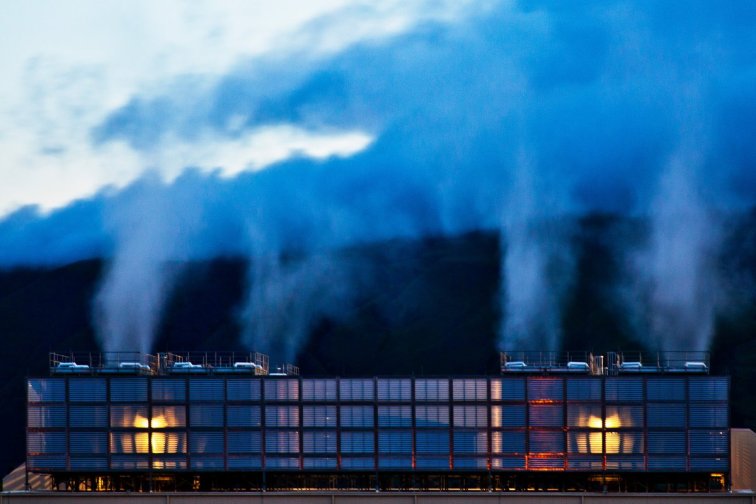Let’s start out with a basic gut check–when you plug in an electric car to charge up the batteries, where do you think that electricity comes from? Magic elves or the same coal burning power plant or nuclear power station that the rest of the world uses?
Sure, you can have a renewable element to the energy mix, but let’s all remember that any activity that sucks down significant amounts of energy has a carbon footprint like anything else. If you really like the Green New Deal, you’ll probably feel like there’s a policy position that has at least the basics covered.
There’s just one problem–one of the biggest users of electricity is not on the list. No, they’re just not included at all in the Green New Deal. And who might that be?
Data centers. And not just any data centers–these are massive facilities owned by Google, Facebook, Amazon and others. Listen up Senator Ron Wyden and Senator Ben Sasse. This is for you.

Upload your latest holiday photos to Facebook, and there’s a chance they’ll end up stored in Prineville, Oregon, a small town where the firm has built three giant data centres and is planning two more. [Hello, Senator Wyden.] Inside these vast factories, bigger than aircraft carriers, tens of thousands of circuit boards are racked row upon row, stretching down windowless halls so long that staff ride through the corridors on scooters.
These huge buildings are the treasuries of the new industrial kings: the information traders. The five biggest global companies by market capitalization this year are currently Apple, Amazon, Alphabet, Microsoft and Facebook, replacing titans such as Shell and ExxonMobil. Although information factories might not spew out black smoke or grind greasy cogs, they are not bereft of environmental impact. As demand for Internet and mobile-phone traffic skyrockets, the information industry could lead to an explosion in energy use.
According to the National Resources Defense Council:
Data centers are the backbone of the modern economy — from the server rooms that power small- to medium-sized organizations to the enterprise data centers that support American corporations and the server farms that run cloud computing services hosted by Amazon, Facebook, Google, and others. However, the explosion of digital content, big data, e-commerce, and Internet traffic is also making data centers one of the fastest-growing consumers of electricity in developed countries, and one of the key drivers in the construction of new power plants.
Why might that be? Here’s some 2011 data from the famous “The Internet is Killing the Planet” infographic inspired by Greenpeace’s “Dirty Data” research (that seems to have been forgotten in the GND):

Based on Google’s most recent environmental report (2018) you have to tease out what Google’s actual carbon emissions is (in footnote 32):
- Google emits less than 8 grams of carbon dioxide equivalent per day to serve an active Google user—defined as someone who performs 25 searches and watches 60 minutes of YouTube a day, has a Gmail account, and uses our other key services.
In Google-speak “less than 8” usually means 7.9999999999. So let’s call it 8. As of 2016 there were 1 billion active gmail users. So rough justice, Google acknowledges that it emits about 8 billion grams of carbon dioxide daily, or 9,000 tons. And based on the characteristically tricky way Google framed the measurement, that doesn’t count the users who don’t have a gmail account, don’t use “our other key services” and may watch more than an hour a day of YouTube. You know, like kids for example.
And that’s just Google. Again from Nature:
Already, data centres use an estimated 200 terawatt hours (TWh) each year. That is more than the national energy consumption of some countries, including Iran, but half of the electricity used for transport worldwide, and just 1% of global electricity demand (see ‘Energy scale’). Data centres contribute around 0.3% to overall carbon emissions, whereas the information and communications technology (ICT) ecosystem as a whole — under a sweeping definition that encompasses personal digital devices, mobile-phone networks and televisions — accounts for more than 2% of global emissions. That puts ICT’s carbon footprint on a par with the aviation industry’s emissions from fuel.

What does this have to do with music? Actually, more than you might think. YouTube is one of the biggest carbon producers in the Google system. What’s consumed the most on YouTube? Cat videos? How-to screw in a lightbulb videos? No.
Music videos.
And then there’s streaming. However you might have felt about plastic discs, billions upon billions of streams uses up a lot of processing power. And it’s like all the world’s music is hosted in the cloud, sometimes literally. Remember “Own Nothing, Have Everything”? I don’t know if anyone could have thought of a more inefficient delivery method from a climate point of view, but I suppose it’s possible.
The fact is we are the forced enablers of what may end up being one of the biggest energy scams in the entire climate disaster, and it’s time to put the foot down. First of all, artists need to start asking questions of services like YouTube and the advertisers who support them.
And clearly, the Green New Deal needs to take a close look at this entire subject.

You must be logged in to post a comment.